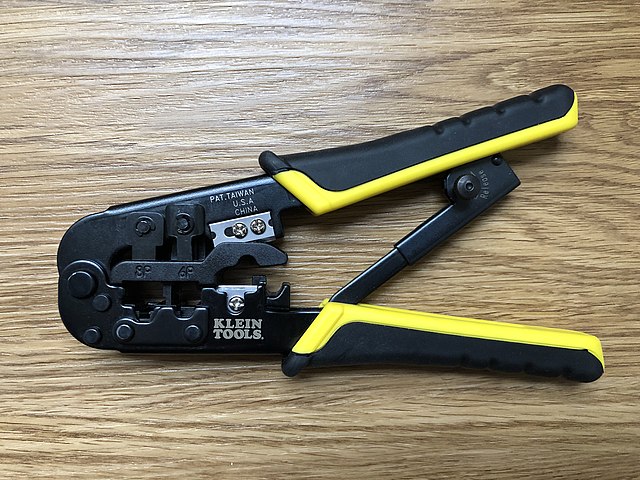Crimper

If you’re building your own cables, then you’ll need a cable crimper. A crimper pinches the modular connector onto the end of the cable (coaxial, twisted pair, fiber).
The crimper comes in at the end of the process. For example, you’ve run the cables from a desk through the ceiling and into a network closet. Now you need to put a connector onto the end of the cable. For example, you’ll put the modular Ethernet connector on and you’ll use the crimper to attach the connector onto the cable.
The crimper pushes the copper inside of the connector into the insulation sheath of the cable to reach the copper in the cable. You’ll now have copper to copper connectivity from the wire itself into the connector
Cable stripper
A cable stripper removes the sheathing of a wire to expose the copper wires within it.
Example of a cable stripper and crimper using to create an Ethernet cable:
Multimeter
A multimeter measures voltage. A multimeter can be used to check if a power source is working or not, or if its providing a different voltage than what is expected. AC can measure AC voltage as well as DC voltage.
Multimeters can be used to provide continuity tests. You can check to see if a fuse is still working. You can checks pins on both sides of a wire to see what pins on one side are connecting to which pins on the other side.
Tone generator and probe
A tone generator helps you to figure out where a wire goes.
- Two separate devices used together to trace cables. Tone generator connects to the cable and sends an electrical signal along the wire at a certain frequency. The tone probe emits a sound when it is placed near a cable connected to the tone generator. The tone probe doesn’t necessarily need to touch the copper to detect the tone.
Cable tester
Cable testers can perform continuity tests. It can be used to identify missing pins or crossed wires. A cable tester can tell you if items are wired properly, but it can’t tell you the quality of the wiring. A cable tester is also used for frequency testing such as detecting crosstalk or signal loss.
Loopback plug
A look back plug is useful for testing physical ports. It takes traffic coming out of a particular interface turns around and sends the traffic back into the same interface. The type of loopback plug that you use will depend on the type of interface that you’re plugging into. For example, you have serial or RS-232 (9 pin or 25 pin) loop back plugs. There are separate loopback plugs for Ethernet, T1, and Fiber connections. Note that these are not cross over cables, which allow you to connect different devices together. A loopback plug is looping traffic from one interface back into the same interface.
Punchdown tool
A punchdown tool punches a wire into a wiring block. You might be punching down into a 66 block or a 110 block, and there are different connectors for the punchdown tool depending on the type of punchdown block you’re using.
A punchdown tool also trims the wires during the punchdown.
Best practice is to maintain the wire twists as you punchdown the wires.

WiFi analyzer
A WiFi analyzer allows you to see all of the wireless communication over a WiFi network. It can provide you with signal strengths and what frequencies are in use. You can determine if there are an errors or interference. A WiFi analyzer can also be used to validate antenna location and installation.
A WiFi analyzer can be a stand alone hardware or a mobile device add on.